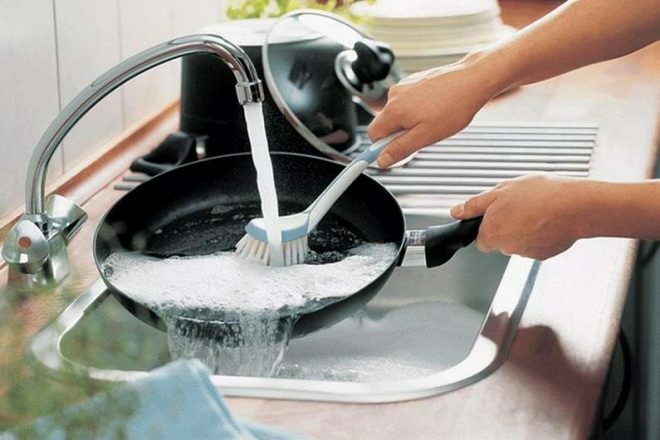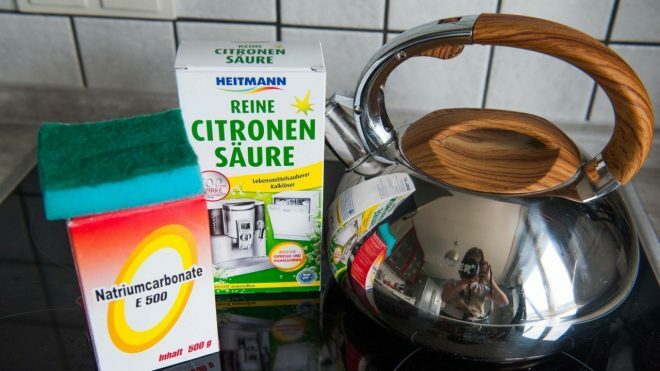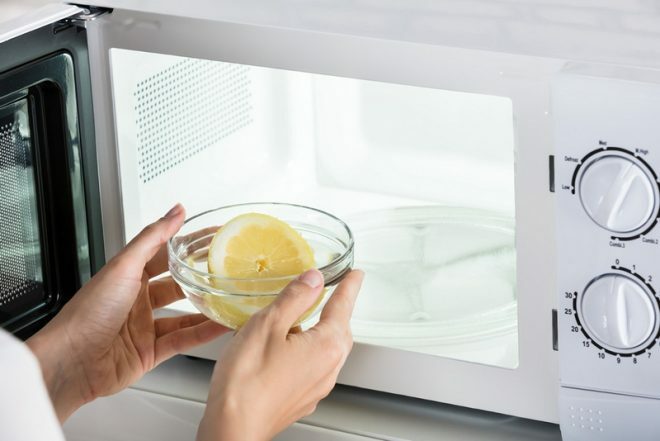A frying pan is a must-have kitchen utensil in the kitchen. Even the simplest dish cannot be prepared without it. This uncomplicated subject has served faithfully for many years. This is especially true for cast iron pans. Housewives have been using them for centuries, thanks to the reliability and non-toxicity of the material. Prolonged or improper use can lead to carbon deposits. Black plaque looks not only not aesthetically pleasing, but also harmful to health. But how to clean a cast-iron pan from carbon deposits and rust? These problems will have to be dealt with with special chemicals and folk methods.

Advantages and disadvantages of a cast iron pan
Before throwing out the old cast iron frying pan, remember and evaluate the dignity of its advantages.
Attention! Earned on our website kitchen designer. You can familiarize yourself with it and design your dream kitchen for free! May also come in handy wardrobes designer.
- Good heat capacity, which allows it to warm up slowly and also cool down slowly. Thanks to this, food cooked in such a dish turns out to be very healthy and tasty.
- Cast iron has a low chemical inertness. This indicates that the metal does not interact with cooked food.
- Metal is not susceptible to rusting.
- Easy maintenance.
Despite the large number of advantages, all items have their own limitations:
- Great weight. All cast iron products are quite heavy.
- Despite the massiveness of the metal, cast iron is relatively tough. It is enough to drop or hit the object hard, as chips may appear.
- It is not recommended to wash cast iron pans with chemical or detergents. After cooking, the utensils must be wiped dry with a napkin. Therefore, it is advisable to have different pans for each dish.
How to clean a cast-iron pan from burnt carbon deposits with folk remedies
Carbon deposits are deposits that appear after exposure to high temperatures on fat. The frying pan is a kitchen utensil that gets soaked every day. It will not be difficult to remove fresh plaque, but you will have to fight with ingrained pollution. Before using a new cast iron product, it is recommended to burn it over high heat with salt to darken the salt. Then grease the entire surface with vegetable oil and place in a preheated oven. This procedure will help to create a kind of non-stick coating on the surface of the product, which will help to avoid food adhesion and carbon deposits. Old cast iron pans can be cleaned of carbon deposits in a variety of ways and methods. Consider the simplest folk remedies for cleaning.
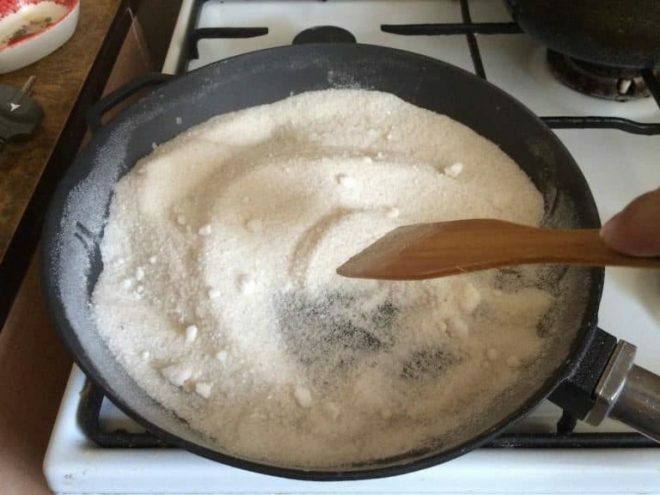
- Digestion with glue. Place the pan in a container with water, into which add 500 grams of soda ash, 100 grams of crushed laundry soap and 100 ml of office glue. Let the liquid boil. Boil the products until the carbon deposits begin to flake off. Then clean the product inside and out with a brush, rinse under plenty of water.
- Ignite using the oven. Line a baking sheet with foil. Place the pan upside down on the foil. Preheat the oven to 200 degrees and above, keep the product for more than two hours. Carbon deposits due to the high temperature will begin to chip off.
- Flame cleaning. The method is good, but not for an enclosed space. It is recommended to put the pan on an open fire for about 15-20 minutes. Then, using a metal brush, remove the remaining carbon deposits.
- Blow torch firing. The method is good, but very dangerous. Direct the flame of the lamp into the frying pan. After five minutes, the carbon deposits are easily removed. When using this method, remember the fire safety rules. This method is not suitable for a closed room.
- Pour sand into a frying pan, put on fire. The cleaning time depends on the degree of soiling. Sand cleaning should last at least three hours. After the time has elapsed, tap the carbon deposits. The only drawback of this method is the unpleasant odor.
- Activated carbon cleaning. You will need 2 packs of activated carbon. Grind the tablets. Moisten the surface of the product and cover well with black powder. Leave it on for a few hours. Wash off the charcoal after an hour with a detergent.
- Cleaning with vinegar. Mix vinegar and water in a 1: 3 ratio. Pour the solution over the dishes and put on low heat for 4 hours. Ensure good ventilation in the room during the procedure. It is better to carry out the procedure outdoors and monitor the amount of water. Soda will help remove the vinegar smell.
Attention! Do not use vinegar cleaning indoors.
- Metal sponge will help not only to clean off carbon deposits, but also to "pump up" your hands. The procedure is difficult and requires a lot of effort and time.
- Laundry soap Grate 50 grams. Pour crushed soap into a frying pan and pour boiling water over it. Close the lid and simmer the liquid over low heat for 1 hour.
- Soda, salt, vinegar. Pour 4 tbsp into the bottom of the pan. l. salt, add vinegar so that it covers the salt. Bring to a boil, then add 100 grams of baking soda, reduce heat. Allow some liquid to cool. After 15 minutes, wash off the mixture with a sponge.
- Laundry detergent and vegetable oil is also able to come to the rescue. Pour a few tablespoons of powder and 5 tbsp. l. vegetable oil. Bring the liquid to a boil. Wash off the product after an hour.
Attention! To avoid a lot of foaming, use a washing machine powder.
- Salt cleaning is the easiest and most popular way. It is suitable for cleaning cast iron and stainless steel pans. It is enough to pour salt into a frying pan, ignite it over low heat.
- Mix 10 grams of borax and a glass of water, add a few drops of ammonia. Spread the solution over the entire surface of the product. Wash off the product after an hour with a sponge and dishwashing liquid.
- Citric acid 1 tbsp dilute a spoon in a liter of boiling water. Soak a frying pan in this solution.
How to clean with household chemicals
Folk methods will help to wash off burnt soot, but many housewives do not want to spend a lot of time, since the result is needed instant. Therefore, they use household chemicals. Special alkaline agents will help get rid of carbon deposits. For example: Antinagar, Shumanit, Amway, Sanita, Fairey. Before using chemistry, be sure to read the instructions. Remember that the chemicals are absorbed into the dishes, therefore it is recommended to use it only on the outer surface.
How to get rid of rust
Rust can appear on cast iron cookware as a result of prolonged contact with water. To prevent this, it is necessary to wash and wipe the dishes well after each cooking. If rust does appear, it can be wiped off with a cleaning agent.
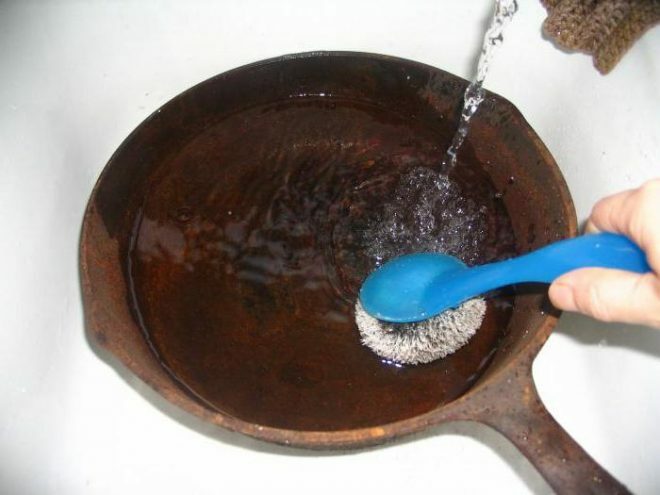
If there is a lot of rust, do not rush to part with your favorite frying pan, there is a way out:
- Digestion with baking soda. Dissolve half a packet of soda in three liters of water. Pour the solution completely over the frying pan and put on low heat. Boil for 5-10 hours, it all depends on the area covered with rust.
- Apply to the area where rust appears white vinegar.
- Sprinkle surface salt and pour lime juice. Leave on for 3 hours. Then wash well.
- Mix borax with lemon juice, apply the gruel directly to the rust. Wash off after a few hours.
- The oven will help get rid of rust. Place the pan in the oven, heat up to 180 degrees and turn on the self-cleaning function. Leave for an hour, let the device cool down and wash with detergent.
- Clean the frying pan abrasive powder or wire brush. Rinse the dishes with detergent, wipe dry. Preheat the oven to 200 degrees, place the product there for an hour. Take out, cool and coat with vegetable oil.
- For cleaning, you can use phosphoric acid. It will take coca cola or pepsi. Pour the drink into a container in which to place the cast-iron appliance. Put the container on fire, the liquid should boil. Then ignite a greased frying pan in the oven.
Attention! After all the manipulations done, rust may remain. It can be removed with a wire brush.
Tips for using and storing a cast iron frying pan
- clean the surface of the pan well after each cooking;
- be sure to wipe the device dry after "water procedures";
- if the pan is calcined in the oven, then you cannot use a metal brush after that;
- after cleaning with vinegar, it is imperative to carry out the soda treatment and the calcination process;
- it is recommended to store dishes only in a dry place;
- it is recommended to bake the pan in the oven as often as possible. This will not only help protect the cast iron, but the food will not burn.
- during cooking, it is advisable to use only wooden appliances;
- do not store food in cast iron.
How to restore a cast iron product after cleaning
After each cleaning, the cast iron surface must be baked with oil. This will help prevent rusting. Annealing creates an oil film that serves as a non-stick coating.
To avoid tedious cleaning of carbon deposits and rust, take proper care of the dishes. After each cooking, rinse off the fat thoroughly with hot water and wipe the surface dry. Remember that cast iron is a brittle metal and can be easily chipped. Therefore, do not wash cast iron utensils in the dishwasher. If properly cleaned, used, stored, the pan will last a long time.
average rating 0 / 5. Number of ratings: 0
No ratings yet. Be the first to rate.
